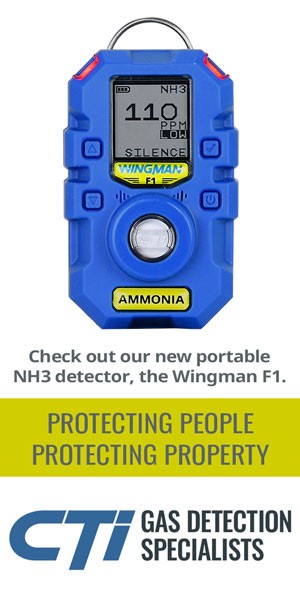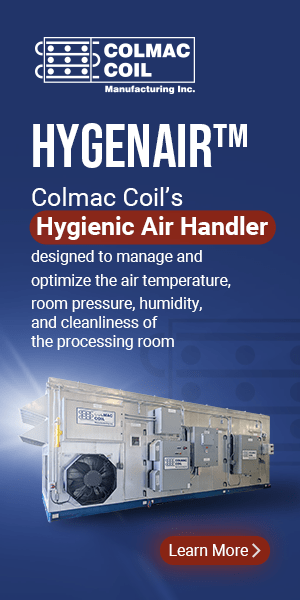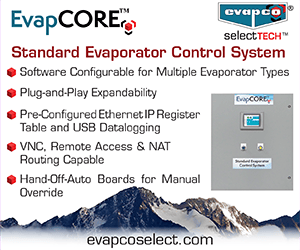IIAR Releases Critical Task Guideline
The “Critical Task Guidance” was designed to assist employers, government regulators, and public safety emergency responders who prepare emergency procedures to address ammonia incidents. The document was developed by consensus among members of IIAR, the Refrigerating Engineers and Technicians Association (RETA), the Global Cold Chain Alliance (GCCA), and the Ammonia Safety and Training Institute (ASTI) and reflects insights from various regulatory agencies.
“This guidance is intended to be integrated into site-specific plans to address pre-event readiness and ammonia release actions. It addresses emergency action training requirements, emergency
action planning, and advocates for the use of air-purifying respirators (APRs) and the circumstances in which they should be used. It is intended to be integrated into new emergency action plans
and/or emergency response plans. It can also be used to strengthen existing plans,” said Tony Lundell, senior director of standards and safety for IIAR.
The guideline identifies three critical tasks associated with the safe operation and maintenance of ammonia systems and response to an unplanned ammonia incident—preparation, escape and system emergency control and rescue.
“It is designed to avoid and address ammonia incidents,” Lundell said, adding that responders often aren’t prepared to deal with an ammonia situation and need additional information.
For example, the guideline recommends wearing an APR when working aloft on equipment that is near charged ammonia systems. This will not only increase the person’s awareness that care should be taken but also prepare them should an incident occur.
The guideline addresses the need and applicability of dealing with medical and rescue duties included in facilities’ Emergency Action Plans and/or Emergency Response plans, as required by 29
CFR 1910.38 and/or 29 CFR 1910.120. It also outlines the extent to which a technician could take offensive or corrective actions when dealing with a release, which can help to mitigate them
and keep them from becoming more problematic.
It also establishes a protocol of awareness training, the necessity of communications, and an incident command system. The guideline offers information about APRs, interpretations
of applicability, a sample leak investigation procedure, guidance on heroic rescue, a sample teaming agreement for local emergency response groups, a sample emergency action checklist, and
other useful information.
Lundell noted that it is important to understand the guideline should be used to augment plans and does not constitute a complete plan.
Companies can reference this guideline and use it as a Recognized and Generally Accepted Good Engineering Practice (RAGAGEP) if so desired. “By a company declaring a publication is
used as RAGAGEP in their programs it will be enforced through PSM/RMP, a local requirement, and/or by the General Duty Clause (GDC),” Lundell said.
However, it is not mandatory to do so. Companies can simply integrate the recommendations into their plans in part or whole. But regardless of their choice, they must still meet the minimum requirements of the regulations. The guideline simply helps them address the specific topics covered within it.
The “Critical Task Guideline” was created because there was a lack of best practice emergency plan information for medical, rescue, and emergency system control available to employers and emergency planners to address the most threatening part of an ammonia operator’s world, explained Gary Smith, president, and chief executive officer of ASTI.
“Cal-OSHA was aggressively going after industry because emergency action plans lacked substance and value when defending the worker from a sudden release of ammonia. This occurs during
maintenance, service, repair, and a sudden failure within the ammonia refrigeration system,” Gary Smith said, adding that Cal-OSHA was correct in pointing out the issue.
The regulations are not specific. They are performance standards that are often interpreted to mean that companies should simply evacuate a facility and call 911 in response to any emergency.
This approach can be problematic in many ways in that the first 30 minutes of a release is usually the most critical time. This is when small releases can be stopped, systems shut down, and an
orderly escape and evacuation should be carried out, said Eric Smith, IIAR’s vice president, and technical director.
“The most frustrating part of the problem was that most of us knew the answer to the problem but adding or changing OSHA regulations is a very difficult process,” Gary Smith said. “We
felt that a better solution would be to give advice to the industry that they could use to upgrade their Emergency Action Plans so that injury of workers would be significantly reduced.”
IIAR, ASTI, RETA, and GCCA all worked together to create the guidance, which Gary Smith said was a sensible solution and a win on all sides. “I think we hit the bullseye on this one,” he said. “From
the standpoint of the leadership, I would say collectively we did a good thing.”
Gary Smith said Cal-OSHA has reviewed the guideline and said it is an excellent compromise between simple evacuation and a full HAZWOPER response requiring specially trained technicians and equipment. He added that a favorable outcome in the TECO case would enhance the importance of this new guideline to safely address releases, whether they are incidental or not.
Gary Smith said the bottom line is that no one should suffer serious injury or death because of an ammonia release if they follow the guidance. He added that 90% of the problem is solved if the operators wear the right type of respirator.
The publication is being published as a guideline, rather than a standard or a bulletin. Bulletins were developed before most of the IIAR standards were created, and before the advent of OSHA’s and EPA’s promulgation of Process Safety Management and Risk Management regulations. The bulletins covered many of the topics that are now covered by standards. “IIAR decided over a decade ago to end publication of bulletins in favor of ANSI developed standards where applicable,” said Eric Smith, IIAR’s vice president, and technical director.
Standards relay prescriptive requirements and undergo the ANSI process of development and review. The industry must follow the standards and regulators are obliged to observe them. Bulletins contained a lot of informative material that was not deemed to be necessary to mandate for minimum safety requirements. So, in keeping with the concept to retire bulletins, such informative
information was either included in standards’ appendices or was re-branded as guidelines. “New informative information on specific topics is being published as guidelines, such as this guidance on emergency action plans,” Eric Smith said. “While it did not undergo the ANSI development process, it’s was a collaborative effort relaying a compilation of good information from various
authoritative resources.”
Guidelines, like the bulletins before them, do not undergo the ANSI process and their use is not mandated by any code or regulation, Eric Smith said. “They are published to help the industry, typically end-users, develop their own methods for high-quality programs that aid them in efficient, safe, and compliant operations,” Smith said.
“And while guidelines are not developed per the ANSI method, they are vetted by a broad range of industry professionals, including contractors, end-users, engineers, consultants, academics, and manufacturers, who participate on the committees that develop or review them as well as the IIAR Board of Directors, which ultimately decides to publish them or not,” Eric Smith explained.
IIAR standards and bulletins serve as the information that regulators respect as “gospel” while a guideline is a collection of good information that has no official standing in the regulatory world, Gary Smith said. “It’s a compilation of good information from many sources outside of the reign of the regulators,” he said.
The guideline is now available for purchase. Like all IIAR guidelines, it will be subject to periodic review by relevant committees.













